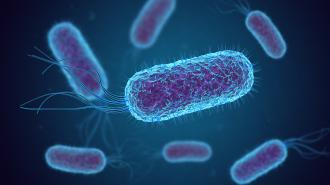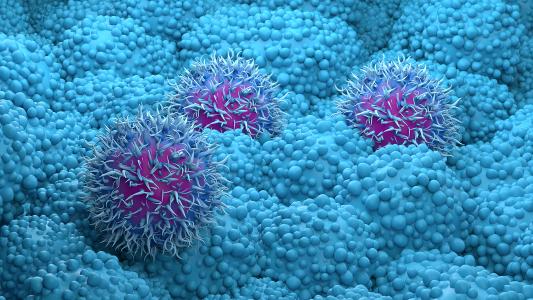Researchers at George Chuch’s Harvard lab have genetically engineered a bacteria, E. coli, to be totally immune to viruses.
In addition to blocking every virus the team has challenged it with thus far, their E. coli has also been designed so that its modified genes cannot escape into the wild, which does indeed sound like the plot of a lost Michael Crichton novel. (In fact, the parallels to Jurassic Park are there, but we’ll get to that.)
“We believe we have developed the first technology to design an organism that can’t be infected by any known virus,” genetics research fellow and study author Akos Nyerges said.
“We can’t say it’s fully virus-resistant, but so far, based on extensive laboratory experiments and computational analysis, we haven’t found a virus that can break it.”
“We believe we have developed the first technology to design an organism that can’t be infected by any known virus.”
Akos Nyerges
Production and protection: The main results of the study, published in Nature, could carry big implications for the future of bacteria-based production — for instance, using bacteria to make medicines.
Cells and bacteria can be used as little labs or factories, cranking out any number of small molecules and biological compounds. E. coli, with its well-understood genome and reputation as a workhorse, is used for the production of almost two dozen biopharmaceuticals, including insulin, and is also being used in making biofuels.
But while harnessing bacteria like E. coli can outsource complex chemistry to organisms for whom it is, ahem, second nature, it also leaves these processes vulnerable to viruses.
“Viral contamination in cell cultures remains a real risk with severe consequences: over the past four decades, dozens of viral contamination cases were documented in industry,” the authors wrote in their study.
Cutting codes: In 2022, a University of Cambridge team thought they had created a virus-resistant E. coli. But when Nyerges, research fellow Siân Owen, and graduate student Eleanor Rand challenged them with random viruses found around Harvard Medical School — including some from a rat nest and the nearby Muddy River — the bacteria proved far from invincible.
The Cambridge attempt hinged on designing the bacteria to make everything it needed using only 61 sets of genetic building blocks, called codons, as opposed to 64. Without those missing codons, the thinking went, the viruses wouldn’t be able to hijack the cells.
To make their virus-resistant E. coli, the team used a special kind of RNA.
This did not prove to be the case.
Rather than being hamstrung, the viruses merely brought in their own genetic pieces, doing an end-around the firewall and getting back to what they do best: infect, replicate, repeat.
Rather than eliminate codons, the Harvard team decided to instead alter what the codons make.
Enter RNA: The new work centers around a specific type of RNA called transfer RNA (tRNA).
The tRNA’s job is to recognize each codon in DNA and then add the correct amino acid to whatever protein is being created — kind of like putting a key component into a car on the factory line. The Cambridge team had deleted codons called TCG and TCA and the tRNA that recognizes them from their bacteria. Both of those codons direct the tRNA to install serine, an amino acid, onto the protein getting put together.
The Harvard team went one step further, by adding in “trickster” tRNAs; when they see TCG or TCA, they install a different amino acid — called leucine — instead of serine.
“Leucine is about as different from serine as you can get, physically and chemically,” Nyerges said.
When a virus busts through the door carrying TCG and TCA, the trickster tRNA slips it leucine instead of serine, creating non-functional virus proteins and blocking it from replicating. (The virus does bring its own tRNA to the party, but the Harvard team believes their cell’s tRNA outcompetes it.)
“It was very challenging and a big achievement to demonstrate that it’s possible to swap an organism’s genetic code, and that it only works if we do it this way,” Nyerges said.
The team thinks it would take a virus developing dozens of mutations — in specific places and at the same time — to hijack their E. coli.
The Harvard team added in “trickster” tRNAs that install a different amino acid. This creates non-functional virus proteins and blocks replication.
Genetic firewalls: Speaking of Michael Crichton, a hallmark of the author’s books is science slipping its bonds and wreaking havoc — think Jurassic Park. The researchers took this concern seriously — a bacteria that can resist all of its natural virus enemies could be a real problem in the wild.
To prevent their genetically engineered E. coli’s code from escaping, the researchers used two different safety mechanisms.
The first was to prevent horizontal gene transfer, a natural process that allows bacteria to swap genes with each other directly. To avoid the engineered code from getting co-opted by a wild bacteria, the team made all the leucine codons in their E. coli into TCG or TCA.
This isn’t a problem for the engineered cells’ trickster tRNA, which uses TCG and TCA to make leucine anyway. But in a non-engineered organism, TCG and TCA are for serine, not leucine. Using serine in place of leucine will lead to junk proteins, genetic code “gibberish,” as Nyerges put it. And if a trickster tRNA itself gets into a normal cell, its amino acid swapping will kill the new cell, hopefully stopping the leak.
For the team’s other safeguard, we go back to Jurassic Park. In the book and film, the animals are made dependent on an amino acid called lysine that the park gives them; without the lysine, they die. Theoretically, this means any dino that escaped would’ve been on borrowed time.
The team’s E. coli was also made to be dependent on an amino acid, one which doesn’t exist outside of the lab. No amino acid, no bacteria.
“We can’t say it’s fully virus-resistant, but so far, based on extensive laboratory experiments and computational analysis, we haven’t found a virus that can break it.”
Akos Nyerges
Next steps: The team next wants to use their codon engineering to create infection-resistant bacteria that can make important materials that would need complicated chemistry otherwise, without the constant risk of contamination by even a single virus.
The work may also prove foundational for genetic engineering going forward.
“Our results may provide the basis for a general strategy to make any organism safely resistant to all natural viruses and prevent genetic information flow into and out of genetically modified organisms,” the authors wrote.
We’d love to hear from you! If you have a comment about this article or if you have a tip for a future Freethink story, please email us at [email protected].






